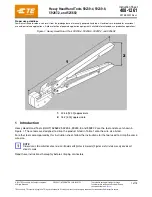
38
Veritas
®
Mk.II Power Sharpening System
It is perfectly acceptable to use the same micro-bevel
sharpening system that you use normally, but I would
not recommend relieving the back half of the bevel
as earlier recommended for Western chisels. Neither
should you use a modifi ed tip on the mortise chisel,
unless you make sure that the lowered angle is well
back into the soft steel. Most Japanese chisels that
I have used will take a wonderfully keen edge, but
they are far more prone to edge crumbling than other
alloys. Woods of inconsistent hardness (such as end-
grain oak) can cause very rapid edge degradation. A
pin knot can take out a piece large enough to make
you weep.
With successive sharpenings the hollow face is going
to get ever closer to the cutting edge. You do not want
it to get much closer than
1
/
8
in. or you risk weakening
the edge, particularly on a mortise chisel. You have
two choices. You can lap the back of the chisel to
effect the necessary recession of the hollowness, or
you can try the Japanese method of tapping it out
with a hammer. I use the
lapping method for two
reasons. First, I have not found the hollow face to
be a discernible advantage in use and therefore am
not concerned about reduction of the hollow through
lapping. Second, I cannot bring myself to use a steel
hammer on a chisel blade because I am convinced that
I would do more evil than good.
But for those of you who are seized with the karma of
Japanese tools, I can recommend two excellent books
that will explain the process of hammering out the
hollow:
Japanese Woodworking Tools: Their Tradition,
Spirit and Use
by Toshio Odate (The Taunton Press,
1984) and
Japanese Woodworking Tools: Selection,
Care and Use
by Henry Lanz (Sterling, 1985).
PLANES
I doubt that there is any hand tool more satisfying to
use than a fi nely tuned plane with a perfectly sharpened
blade. The ease of use, the consistency of results and the
general feeling of craftsmanship generated create one
of the magic moments of woodworking.
Sharpening the blade perfectly is a relatively easy task
compared to the fi ne tuning. The production process
that is used for most bench planes today seldom creates
an end product that is ready for use even if it came with
a sharp blade – which it usually does not! When you
buy a new plane you are usually getting a collection of
parts that can only be converted into a fully functioning
tool with a fair amount of thought and a substantial
amount of work.
Tuning a Plane
There is little point in sharpening the blade well if it is not
going to be seated well on the bed of the plane or clamped
in place in a manner that will minimize fl exing of the iron
in use. A quick checklist to put the plane in reasonable
working order would include the following steps:
1.
Strip off the lacquer:
First, remove any lacquer
from the plane blade, the sole of the plane and the
sides. It is only there to make the plane look good and
prevent it from rusting until it is sold. After stripping,
you can wax any parts you won’t be abrading. The
wax will prevent rusting and reduce friction.
2.
True the sole:
With the blade in the plane and the lever
cap in position tightened for use, lap the sole of the
plane until it is flat. Lapping can be done in a variety of
ways, but the most practical method in a small shop is
to use silicon-carbide grit on a cast-iron lapping plate,
or on a fairly firm plastic sheet such as Mylar fixed to
a sheet of plate glass with spray adhesive.
Start with about a 90 grit and do not move to a finer
grit until the sole of the plane is flat in all critical
areas. (Change to a finer grit only to get the degree
of smoothness that you want on the plane’s bottom.)
Use a slightly circular or figure-eight motion in
lapping to keep the grit evenly distributed under the
sole. Take care to keep the pressure directly down
on the plane with no tendency to tilt it.
The Anatomy of a Plane
Depth-adjustment
screw
Lateral-adjustment lever
Tote
Heel
Frog
Blade or iron
Lever cap
Cap iron or
chip breaker
Sole
Cheek
Mouth
Toe
Knob
Machined
faces
Summary of Contents for Mk.II
Page 6: ...vi Veritas Mk II Power Sharpening System ...
Page 14: ...8 Veritas Mk II Power Sharpening System ...
Page 20: ...14 Veritas Mk II Power Sharpening System ...
Page 33: ...27 Exploded Assemblies Master Parts List 5 3 13 9 7 2 14 24 21 1 6 22 20 19 18 17 16 15 23 4 ...
















































